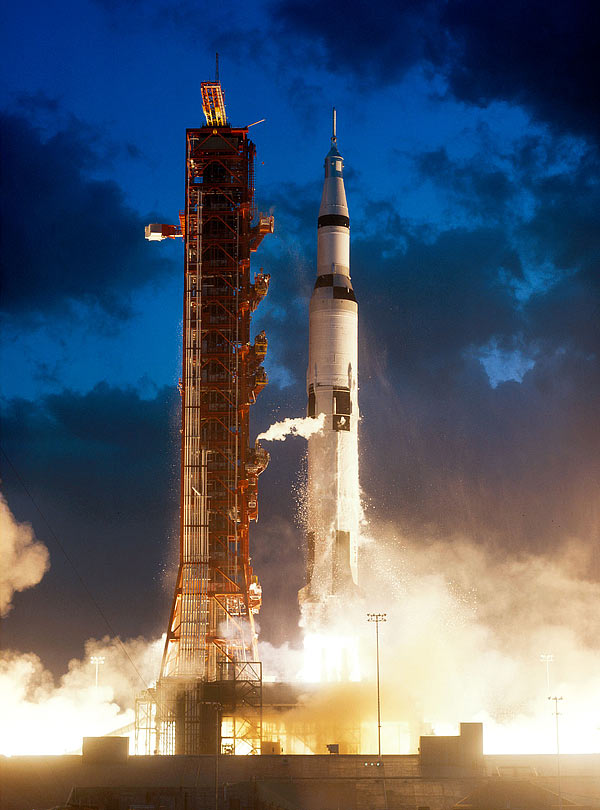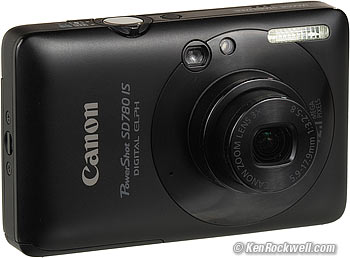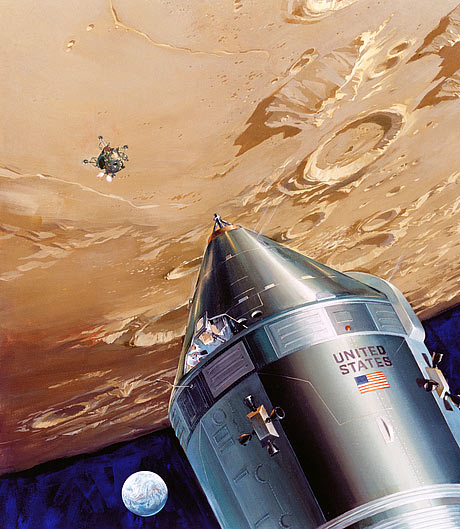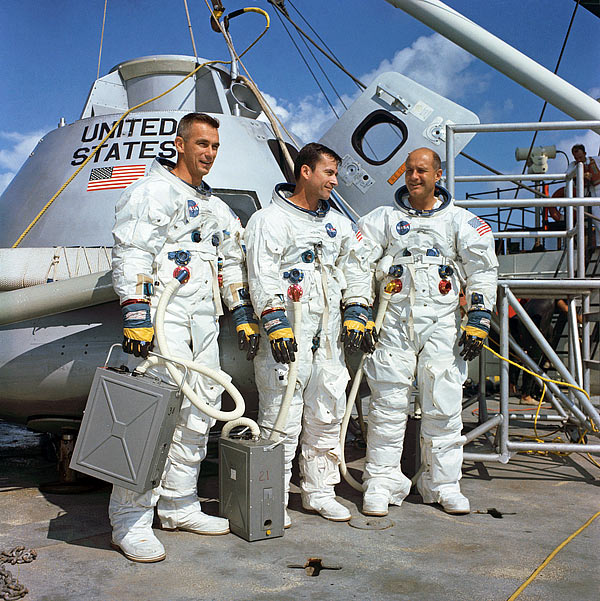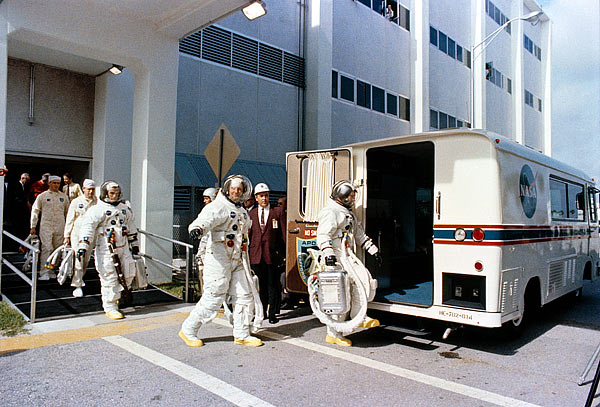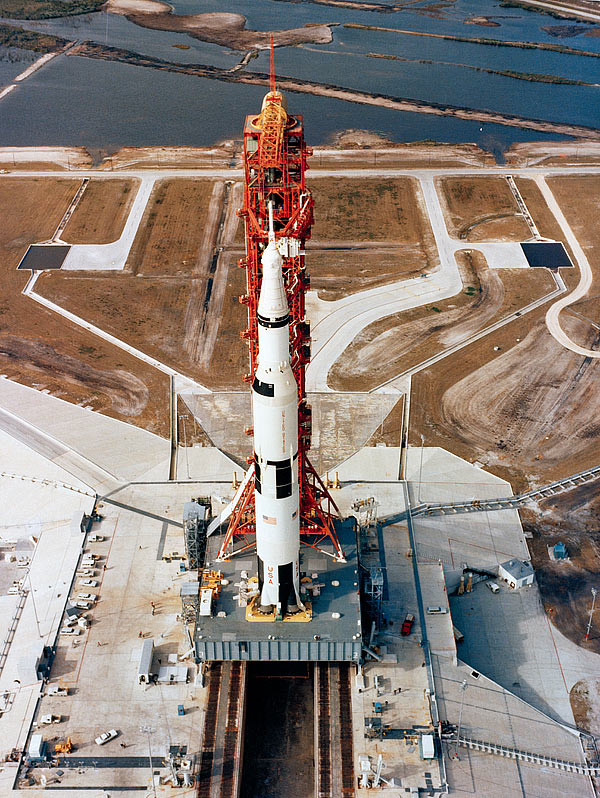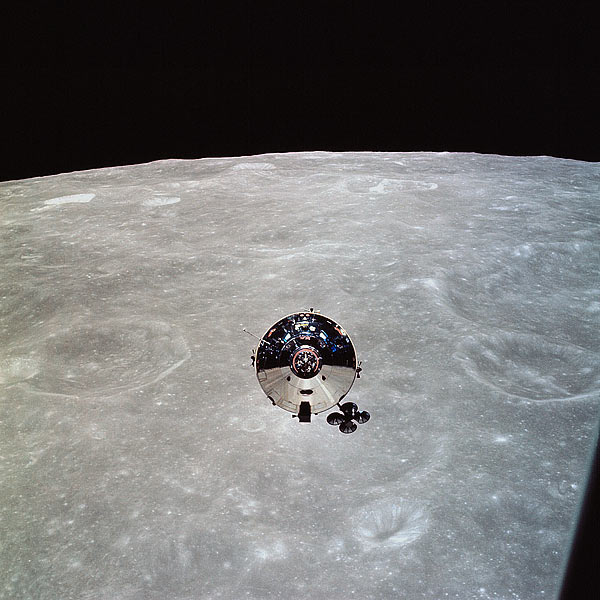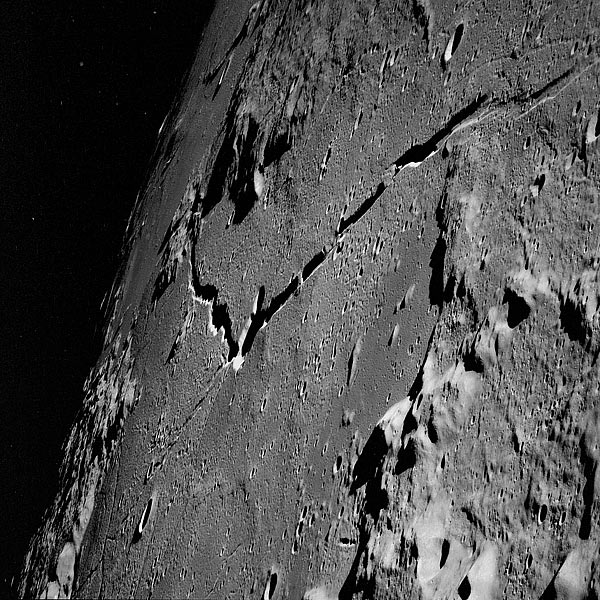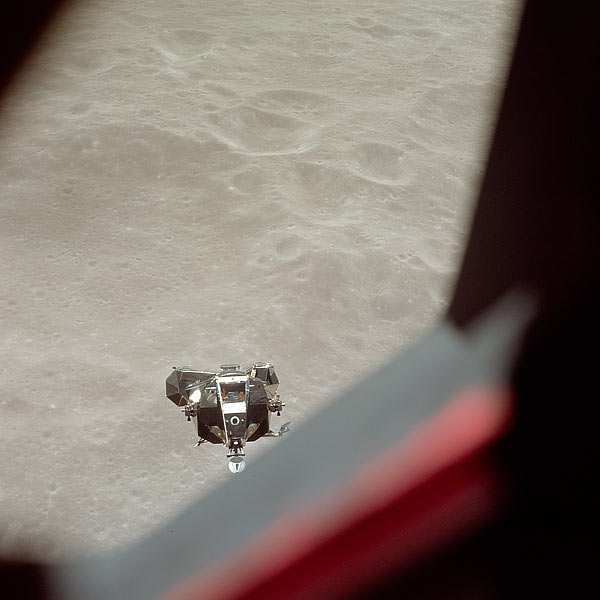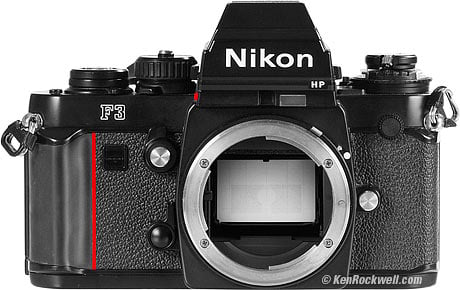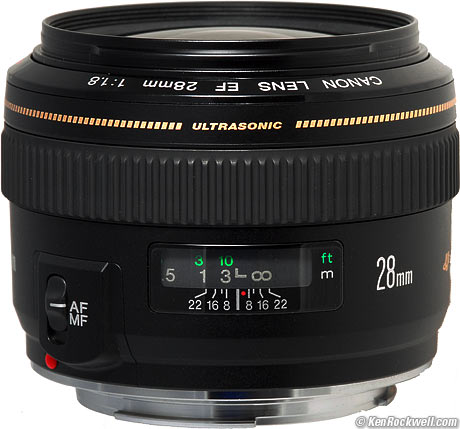Home Donate Search Gallery How-To Books Links Workshops About Contact
Early July 2009's
Updates RSS: live daily
all © 2009 KenRockwell.com. All rights
reserved.
See also 16-19 July 1969 (launch), 20-22 July 1969 (Lunar landing) and 23-27 July 1969 (triumphant return).
15 July 2009, Wednesday

Good morning class. Today's lesson is about the number five. Can you count to five? Good.
Today is the fifth day before the fortieth anniversary of Man's first walk on the moon.
Tomorrow is the fortieth anniversary of the launch of the rocket that brought men to the Moon. If you're in Florida, be sure to be at the Kennedy Space Center's Apollo/Saturn V Center by 10AM, where Apollo astronauts Buzz Aldrin, Charlie Duke, Al Worden, Edgar Mitchell and Walt Cunningham will be there to celebrate as well.
Does anyone know the name of the kind of rocket that got him there? (Every American man and boy knows this, and I just gave you a big hint.)
It is called the Saturn V. The "V" is the Roman numeral five. We are going to learn about the Saturn V today so that we can appreciate what is going to happen tomorrow when we celebrate the fortieth anniversary of the launch of Apollo 11, which brought the first men to walk on the Moon.
For those of you late to class yesterday and Monday, please also scroll back down and see additional material I added late last night. I added great high-resolution photos from Apollo 10's dress-rehearsal mission, added descriptions of the overall what happens when during an Apollo mission to the Moon, added descriptions of the Command and Service Modules, and added notes about Apollo 8, where the astronauts read to the world out of the book of Genesis from orbit on Christmas eve.
![]()
Now back to the Saturn V.
The Saturn V is the most powerful rocket ever created by the hand of Man. Here is a photo of a Saturn V in action:
Liftoff of Apollo IV: 7AM EST, 09 November 1967 at Pad A, Launch Complex 39, Kennedy Space Center, Florida, USA. enlarge.
But wait — not only is the Saturn V the most powerful rocket, the Saturn V is also the most powerful device every created by the hand of Man that doesn't blow itself up in the process.
How powerful is a Rocketdyne F-1 rocket motor which powers a Saturn V rocket?
The Rocketdyne F-1 motor burns fuel (RP-1), mixed with pure liquid oxygen (LOX), to make enough gas to spin a turbine.
Class, how much power does this turbine have? Hint: think fives.
![]()
The turbine of the Rocketdyne F-1 motor produces 55,000 horsepower.
How powerful is this? It is the power of twenty locomotives. It is more than one-hundred times more powerful than the supercharged V-8 powerplant of a Mercedes E55 AMG. It is five hundred times more powerful than the Japanese Prius, popular with Americans for use as golf carts.
But wait — 55,000 HP spins a turbine. What does this turbine do?
This turbine spins two pumps: one for rocket fuel, and the other for liquid oxygen.
These pump 40,000 gallons per minute of rocket fuel and liquid oxygen. Do you know how hot the gas is that spins the input vanes to this turbine? About 1,500º F. Do you know how cold liquid oxygen is when pumped around? 300º F — 300º F below zero. For homework, go home and try to build a machine that can work with all these temperatures at once.
Do you know how much 40,000 gallons is? My parent's backyard pool only holds 10,000 gallons. That means this pump could suck out our pool in 15 seconds! Could you swim from one side to the other that fast? I couldn't.
As of 2010, all the gasoline used in the entire United States is only 4,400 gallons per second. That's everything put together!
Now that we have 40,000 gallons per minute of fuel and liquid oxygen flowing, what do you think a Rocketdyne F-1 motor does with it? (girls in the class fidget, asking themselves "who cares," while Billy raises his hand.) Yes, Billy? Billy enthusiastically responds "BURNS IT!"
Very good, BIlly. The Rocketdyne F-1 motor burns 40,000 gallons of fuel and oxidizer per minute, or 5,000 pounds per second. If all the metal and glass and everything that makes a Prius could be turned into something more useful, like fuel and oxidizer, the F-1 motor could consume more two complete Priuses per second. (The F-1 of course consumes as much combined propellant as 2.4 million Priuses.)
How does the Rocketdyne F-1 burn fuel? It burns it by mixing the fuel and oxidizer together in a huge nozzle.
When you burn this much propellant, what happens?
![]()
That's right: you generate two-hundred-million horsepower, or 150,000 MegaWatts of power.
When Rocketdyne first test-fired motors like this at its Santa Susana Test Facility in the suburbs north of Los Angeles, windows shattered ten miles away. (Your teacher has a photo of himself in front of their entry sign back in 1985: it was called Rockwell back then.)
How powerful is 150,000 MW? It is as powerful as 150 typical nuclear power plants.
What do we do with all this power? This power is used as thrust to lift a rocket. How much thrust do we get?

This is as much thrust as five-hundred Plymouth 426 Hemi Barracudas tied together.
Billy has his hand up again. Yes Billy? "But Mr. Rockwell, the Hemi 'Cuda only gets that much thrust in first gear!"
Yes, Billy is correct. 500 Hemi 'Cudas have as much thrust as a Rocketdyne F-1, but the Hemi 'Cuda has to shift out of first by about 30 MPH. 30MPH doesn't do much to get us to the moon. As you upshift, a car's thrust drops. The Saturn V acelerates the spacecraft to 6,000 miles per hour, or about Mach 8. (to compute a car's thrust, multiply its engine torque by the transmission and rear axle ratios, then divide by the rear wheel's radius in feet.)
You would think 1,500,000 pounds of thrust would be enough. This is as much as all the three motors of the Space shuttle put together, but too much is never enough for Americans.
Americans do loud and powerful real well, but to go really fast, it takes German design.
We wanted to go really, really fast, so we asked Dr. Wernher von Braun see what he could do.

Dr. von Braun figured that if one Rocketdyne F-1 motor, the world's most powerful rocket motor, was good, then using five of them at the same time was even better.
Yes, class, the Saturn V uses five Rocketdyne F-1 motors, for a combined thrust of 7.5 million pounds, and the world's only device capable of a sustained
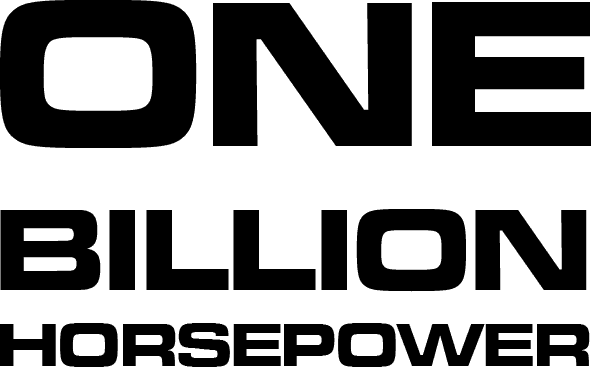
As designed, the Saturn V only holds about four and a half million pounds of propellant, through which it burns most of it in 152 seconds. If you have bigger tanks, it could go longer.
How fast do five F-1 motors suck propellant? They suck it at over 3,000 gallons per second, enough to empty my parent's pool in three seconds!
Fill my parents pool with rocket fuel and liquid oxygen and burn it this fast, and you have a party.
All the power of which I just spake is just the first stage.
The Saturn V has two more stages which propel the rocket even further after the billion-horsepower first stage burns out of fuel.
To hold this much fuel and oxidizer, the Saturn V rocket is over 360 feet (110 meters) tall.
Does anyone have any idea just how big this is? Of course not, unless you go visit the Kennedy Space Center museum and see this thing on display.
It is so big that they had to build one of the world's largest buildings just to hold it. Amazon would be proud.
This thing is so big that it won't even fit on a football field. It's too long.
It is 33 feet (10m) in diameter. When you see this thing hanging over your head in the museum, only then does the gravity of how insanely crazy the astronauts had to be sink in.
At the museum you will also see the tiny passenger compartment of the Command Module. The passenger compartment makes even a Japanese car seem like a living room by comparison. The three astronauts had to squeeze together closer than people in a movie theater, but there was no place to get up and walk around, or go to the bathroom. They had to stay in their seats for the entire week of the mission and pee and poo in their own pants.
Were these seats comfy? No. They are webbing over tubular aluminum, the same as cheap beach chairs.
Now, class, if I were to offer you the chance to get locked into a small container and have to stay sitting in a small seat for a week, for a chance to go to the moon, who wants to go?
(most boys raise their hands enthusiastically.)
At the KSC museum, the second thing you notice after the size of the Saturn V is that the motors are but a tiny part of this thing. It is huge, but entirely hollow!
Do you know why the insides are all hollow? The Saturn V is mostly just an empty tube!
We fill it with over four million pounds of propellant. Do you know another word for "propellant?" Yes, we completely fill the Saturn V with high explosives.
Now, class, if I offered you the chance to have to sit in that little cabin, but sit on top of a 300-foot-tall tank full of over four million pounds of liquid high-explosives which we will light off to send you to the moon, now who wants to go now?
Every boy's hand goes up, and the sound of "ME!! PICK ME!!!!" deafens everyone in the room, while the girls look confused.
The boys' enthusiasm is unabated when I explain that the Saturn V has the usual range safety provisions, meaning that if it goes unstable and looks like it's going to flip around and fly back into neighboring Palm Beach (as one of Mr. Rockwell's early attempts at model rocketry did, coming right back at me with a lead-weighted nose cone holding a sharpened iron rod which put a hole in the steel wall of the same swimming pool that I've been using as reference!), all someone has to do is push a button and the Saturn V is blown to smithereens, so far to smithereens that the two propellant components are hopefully dispersed so well that they don't combine in to one Hellish fuel-air bomb.
As a final exercise, let's compute the fuel economy of an Apollo mission, which holds 4,500,000 pounds of propellant. First we need to convert from pounds into gallons.
Most boys know that RP-1 rocket fuel is 6.76 pounds per gallon (0.81 g/ml), and that LOX is 10 pounds per gallon. We burn them at a 2.27:1 oxidizer to fuel ratio, so algebra tells us the resulting density is about ((2.27/3.27) * 10) + ((1/3.27) * 6.76), or 6.9 + 2.1 = 9.0 pounds per gallon. Thus the Saturn V holds 4,500,000 pounds / 9 pounds per gallon, or conveniently 500,000 gallons of propellant.
How far is an Apollo mission? The Moon is 250,000 miles away, so a round-trip, excluding orbiting, is also an even 500,000 miles, or one MPG. Not bad for three guys at the same time!
One girl, Suzy, mumbled something about boys being stupid and wasteful, and how her mommy's Prius is good for the environment. Billy quickly set her straight: "Yes, a Saturn V with its five F-1 motors consumes fuel at a rate equal to 12 million Priuses, but the Saturn V only does this for 152 seconds, while your mommy's Prius, as well as everyone elses' Prius, is polluting the would for all of us forever, just to bring your selfish, lazy butt to school or work each day. The fuel consumed by all the roughly ten Saturn Vs that have been launched over all time used only as much fuel as all your self-righteous pig's Priuses combined consume every couple of hours."
Billy's right: Big business wants you to think that buying their stuff and consuming saves the planet, while in fact it's the worst possible thing you can do.
If Suzy's mommy really cared about the environment, instead of simply seeking commercial rationalization of her wasteful and lazy ways, Suzy would walk to school (or take the bus) and her mommy and daddy would bike to work, as Mr. Rockwell did his entire office-job career.
Maybe the Saturn V emitted CO2, but it did most of it into space.
THe astronauts drank their own recycled pee, while most Prius drivers use drinking water to shower, water their lawns and flush their toilets.
People driving Priuses are destroying the planet; there are zillions of them consuming a little less gas than other cars, but 50% less gas multiplied by millions of Priuses driven every day is still far more fuel than people who bike to work and drive a hot rod once a month. "But I have to drive" is no excuse: if you drive a car to to work — any car — you are the problem. Simply buying a different car, or sending money to an environmental organization, does not excuse you. Gas-sucking hot rods sitting unused in people's garages consume far less fuel than the millions of Priuses, Camrys and Tauruses driven every day.
So why does government seem to tell us that buying new cars is the solution? The Golden Rule: He who has the gold, makes the rules. Car makers spend millions of dollars a year on bribes (lobbying) in government, while bike companies like Trek and Specialized aren't big enough to twist government to make rules in their favor instead of the car companies.'
Class dismissed until tomorrow, the fortieth anniversary of the Moon launch.
14 July 2009, Tuesday
Canon SD780, about actual size.
NEW! Canon SD780 Review. A tiny camera that works great and disappears into your pocket.

Six days to the 40th anniversary of Man's greatest achievement: the Apollo 11 landing of men on the Moon and returning them safely to the Earth.
It's only two days to the 40th anniversary of the launch of Apollo 11.
If this isn't exciting stuff, you must not be breathing. The Apollo program is what taught the world that nothing is impossible, and has provided inspiration to me all these past 40 years. I watched all this unfold live in the 1960s.
Commemorating prior flight Apollo 10
North American Rockwell Artist's Concept of Apollo 10. bigger.
This artist's Concept shows the Lunar Module descending to 50,000 feet for a close look at a potential lunar landing site.
Apollo 10 was the dry run of the Apollo 11 mission. Everything was the same, except the actual lunar landing.
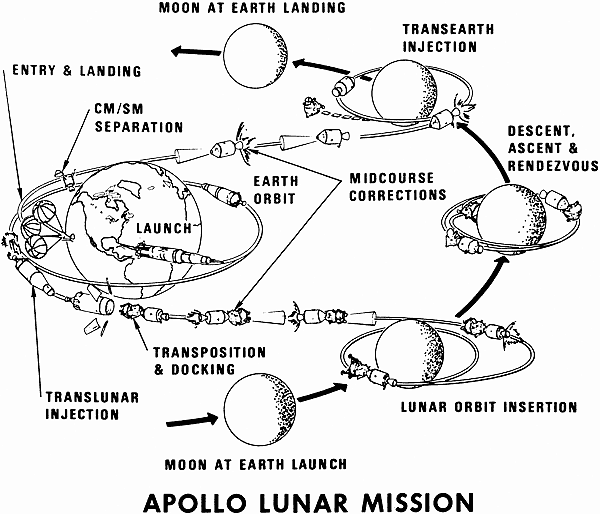
Apollo Mission Overview.
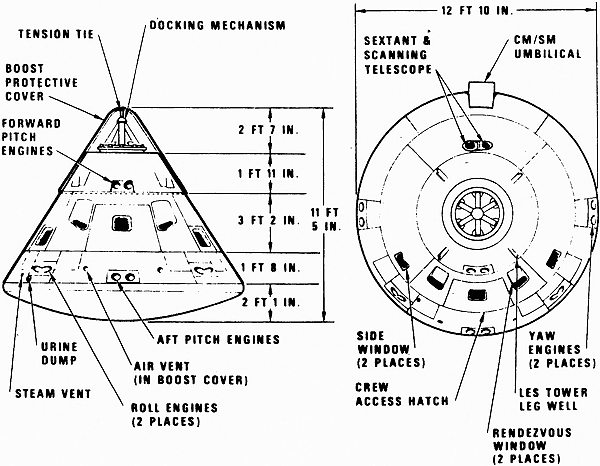
Command Module Overview.

Command Module Interior.
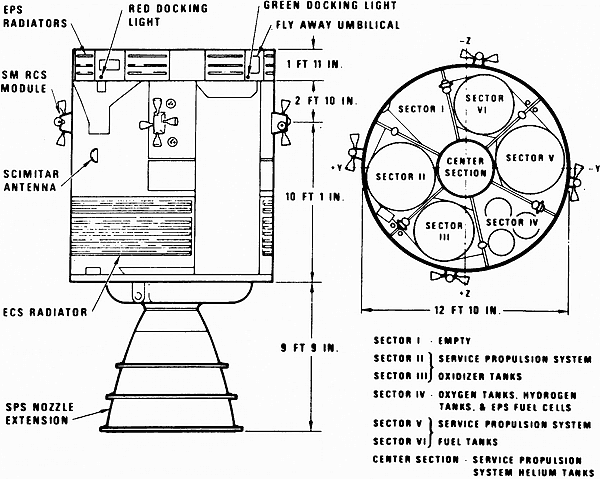
Service Module.
The second mission to orbit men around the Moon, Apollo 10 was the first mission that flew the full Apollo spacecraft, consisting of the Command and Service Module (CSM-106, "Charlie Brown") and the Lunar Module (LM-4, "Snoopy").
Apollo 10 demonstrated crew, space vehicle, and mission support facilities and evaluated Lunar Excursion Module (LEM) performance around the Moon.
Outcome: 100% successful, although there was an anomaly in the automatic abort guidance system aboard the LEM.
Men:
The Crew of Apollo 10 (as chosen by NASA on 13 November 1968) bigger.
Left to right:
Eugene A. "Gene" Cernan, lunar module pilot,
John W. Young, command module pilot, and
Thomas P. Stafford, commander.
Gene Cernan later walked on the surface of the moon 11 December 1972, during Apollo 17. Gene is the last man to have walked on the Moon, but he left the door open and the lights on. Why has no one else been able to follow our lead? Will America have to lead the world back to the Moon, again? Will the world really let forty years slip behind them?
Astronaut John W. Young, command module pilot leads, followed by astronauts Thomas P. Stafford, commander and Eugene A. Cernan, lunar module pilot, entering the transfer van which carried them to Pad B, KSC Launch Complex 39, where their Apollo 10 spacecraft awaited them. bigger.
The Apollo 10 on Saturn V booster. bigger.
Apollo 10 Liftoff: 18 May 1969, 9:49:00 AM, Pacific time.
11 minutes after launch, Apollo 10 was inserted into an Earth parking orbit at 10:00:54 AM Pacific time, followed by translunar injection (TLI) after 1 1/2 orbits at 12:28:21 PM Pacific time.
What this means is that Apollo 10 got launched, and 11 minutes later was in orbit around the Earth. It orbited one and a half times, picking up speed in the process. Then it fired some more rockets to redirect it towards the moon.
Earth seen from Apollo 10 just after trans-lunar insertion. bigger.
Once on its way careening towards the moon, mostly under inertia (no need for power, it coasted), the Command and Service Module (CSM) separated from the Saturn V third stage (S-IVB) at 12:51:42 PM Pacific time, flipped around, and docked with the Lunar Module (LEM) at 1:06:37 PM Pacific time.
The modules have to flip around (transpose) because they are launched in separate compartments of the Saturn V. The Command Module is at the very top of the rocket, while the LEM is inside the Saturn V, below the Command Module as launched.
During and before launch, the Command Module has a small tower of other rockets attached to its nosecone. These can be fired to lift the astronauts and Command Module to safety if anything screwy happens during launch.
After launch, those auxiliary rockets are jettisoned, the LEM comes out of the Saturn V, and the two have to be bayoneted together while flying through space.
They have to have their access hatches mated so that Astronauts can climb between the Command and Service Module (CSM) and the Lunar Excursion Module (LEM) while in flight.
Orbited Moon: 21-22 May 1969.
After three days of coasting towards the moon, helped of course by calculations involving gravity, Apollo 10 entered an initial lunar orbit on 21 May 1969 at 1:44:54 PM Pacific time, using a 356 sec. SPS burn. A second SPS burn lasting 19.3 seconds circularized the orbit to 113.9 km x 109.1 km.
The next day, on 22 May 1969, Stafford and Cernan climbed into the LEM and fired the SM reaction control thrusters to separate the LEM from the CSM at 12:36:17 PM Pacific time.
The Command and Service Modules (CSM) as seen in lunar orbit from the Lunar Module (LM) after CSM/LM separation. The CSM was about 175 statute miles east of Smyth's Sea and was above the rough terrain which is typical of the lunar farside. The eastward oblique view of the lunar surface is centered near 105 degrees east longitude and 1 degree north latitude. The horizon is approximately 375 miles (600 kilometers) away. Numerous bright craters and the absence of shadows show that the sun was almost directly overhead when this photograph was taken. bigger.
The LEM was put into lunar orbit to allow low altitude passes over the lunar surface, the closest approach bringing it to within 9 miles (14 km) of the Moon. All systems on the LEM were tested during the separation including communications, propulsion, attitude control, and radar.
Stafford and Cernan snapped numerous close-up shots they flew over the Moon, especially of the planned Apollo landing sites. The Hasselblad 500 ELs got their usual workout.
Lunar surface as surveyed from Apollo 10 LEM. bigger.
The LEM descent stage was jettisoned into lunar orbit. The LEM descent stage is the lower half that would have stayed on the moon if they had landed, and from which they would have blasted-off back into lunar orbit after walking the moon. Apollo 10 was just the dress rehearsal; Apollo 11 actually lands.
Here's what John W. Young, Command Module Pilot, shot from the Command Module with the Hasselblad 500 EL as the Lunar Excursion Module approached:
View of LEM returning to Apollo 10 after orbiting Moon. bigger.
The Apollo 11 LEM and CSM rendezvous and redocking occurred 8 hours after separation at 8:22 AM Pacific time the next day, 23 May 1969. In other words, Cernan and Stafford just spent 8 hours in the LEM snapping photos as they orbited low over the Moon.
Later on May 23, the LEM ascent stage was jettisoned into solar orbit. The ascent stage is the upper half of the LEM in which the astronauts traveled.
On 24 May at 3:25:29 AM Pacific time, after 31 lunar orbits and with all the three men in the Command and Service Module once again, the CSM rockets fired for trans-earth injection, meaning they shot the craft back to the direction of Earth.
Returned to Earth: 26 May 1969.
In Earth orbit after two days hurtling back, CM-SM (Command Module - Service Module) separation took place on 26 May at 9:22:26 AM Pacific time. The Command module is the tiny, conical-shaped module in which the Astronauts rode, while the Service Module is the larger cylindrical section to which the Command Module was attached for all of the previous part of the trip. The Service Module held the motors, fuel and other things needed for the trip, and they separate so that all those motors don't come flying out of the sky along with the Command Module and the men at the same time.
The Command Module was designed with a curved bottom covered in tiles. The CM was designed to plummet butt-first through Earth's atmosphere, with those tiles getting flaming hot as the CM careened towards Earth like a meteor. This is another reason they needed to dump the Service Module which rode below the Command Module. When flying as fast as a meteor through space, you can't use parachutes to stop you.
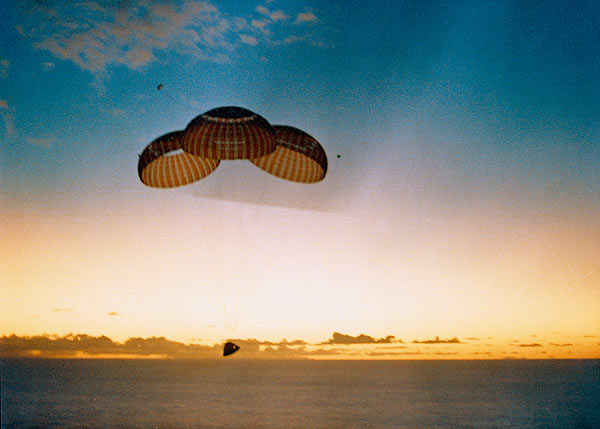
Apollo 10 slowed to only a couple of hundred MPH as it got closer to Earth and its thicker, lower altitude atmosphere and was able to pop its parachutes without destroying them instantly as it splashed-down into the Pacific Ocean on 26 May 1969 at 9:52:23 AM Pacific time, after a mission elapsed time of 192 hours, 3 minutes and 23 seconds. The splashdown point was 15 deg 2 min S, 164 deg 39 min W, 400 miles east of American Samoa and 5.5 km (3.4 mi) from the recovery ship USS Princeton.
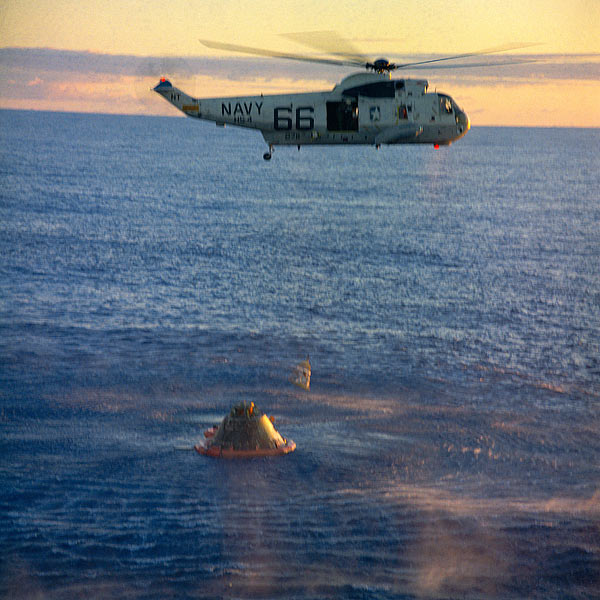
This was one heck of a ride!
Splashdown was a little before 10AM California time, but remember these guys were out in the middle of the Pacific Ocean, where the sun was just coming up.
(All photos: NASA, and thank God they were shot in RealRaw so we can still see them today!)
13 July 2009, Monday
NEW: See the JFK Library's Flash recreation of the entire Apollo 11 flight. I may do nothing this next week but sit home and watch it as I did as a 7-year-old back in 1969 on TV. Unlike the original Apollo 11 mission, which was seen around the world on TV without a hitch, this site uses Flash 10, which I had to download from Adobe.com.
As I see it, it's now 64 hours and counting down to liftoff.

Seven days to the 40th anniversary of Man's greatest achievement: the Apollo 11 landing of men on the Moon and returning them safely to the Earth.
Commemorating historic flight Apollo 8:
Liftoff: 21 December 1968
Splashdown: 27 December 1968.
The astronauts read to the world from the book of Genesis during a live Christmas Eve television broadcast
Apollo 8 was the first time in history where men had left Earth's gravity and orbited the Moon.
Outcome: 100% successful.
Men:
Frank Borman, Commander.
James A. Lovell, Command Module Pilot.
William A. Anders, Lunar Module Pilot.
The Apollo 8 command module now resides in the Chicago Museum of Science and Industry.
Why has no other country flown men to the Moon? Is it a lack of resources? Will none of them get there in the next seven days to challenge 40 years of American leadership? How sad is it that after 40 years, no other country has been there? We went there as a goal to open it up to everyone. Is there really no other nation or private concern able to duplicate this? Is America really that far advanced? Are we the only ones this crazy?
Yes, Grissom, White and Chaffee were burnt to their deaths within 17 seconds in a prelaunch test of Apollo 1 on 27 January 1967, but we changed the capsule design and kept on going according to our plans and landed men on the Moon 2-1/2 years later. The only difference between winners and losers — between failure and success — is that losers give up. Winners never give up. It took Thomas Edison over 10,000 tries until he made the first practical light bulb!
No one said reaching the Moon was easy or safe, but we did it in spite of all odds.
Photo Contest
This also means only seven more days to enter the National Wildlife Federation's photo contest, deadline: 20 July 2009.
12 July 2009, Sunday

Eight days on the countdown: 40th anniversary of Man's greatest achievement.
11 July 2009, Saturday
YES! My Nikon D40 Guide iPhone (iPod) App has only been out two days, and has already made Apple's top 25 for photography apps. Yipee!
I guess we'll have to crank out the same for the D90 and D700 next.
I'm glad you folks dig it: it's got seven five-star ratings as I checked this morning, and I'm still working on ways to make it better as an update.
The iPhone/iPod platform is a great way to carry these guides with you, and from the workshops I've done, it seems like half of you already have iPhones. If not, I bought my iPod Touch as a goof in October, and I've been addicted to it ever since.
The $215 iPod Touch is the only computer I need on the road. I get full free access to any open Wi-Fi network (they are everywhere), and can do anything I need to on the road. It can't store or Photoshshop photos as far as I know, but it does get the internet, weather, email and everything else you'd do on a 5-pound laptop, and lets me take all my photo notes as I shoot in the Notes function. I don't want to be working on my photos on the road anyway; I'm too busy shooting.
I prefer the iPod Touch over the iPhone. The iPod Touch is less expensive to buy, and then free after you buy it, and half the thickness and weight of the iPhone. The iPod Touch runs for days on a charge. The iPod Touch gets fast Wi-Fi, not crappy phone Internet, and that's great, because phone (3G) Internet is so slow that I wouldn't use it anyway.
With my iPod Touch, if I can't get a free Wi-Fi signal at the moment, I wait until I can, instead of dealing with the painfully slow — and expensive —phone company 3G connections. Free Wi-Fi is much faster.

Nine days on the countdown: 40th anniversary of Man's greatest achievement.
10 July 2009, Friday
NEW: Photos from Monterey. These are what I got on Dave Wyman's Steinbeck Country trip last month.
Amazon sells the Nikon F3!
Nikon F3
I kid you not: you can buy the Nikon F3 (used) through Amazon.
What will they think of next?
New: Nikon F3 Review. I finally wrote it up. I've had a draft there for years.
Say no to rip-offs
Don't ever pay anyone more than $200 for a Nikon 35mm f/1.8.
If you do, you only encourage the lower rungs of society to buy up all they can from honest dealers that sell them for $200 and try to resell them for personal profits.
It's already started to happen with the 35/1.8, just as it did for a couple of years with the 18-200mm VR.
If no one buys from dishonest private parties at inflated rates, then these bottom-feeders will have no incentive to hoard the lenses, and then they won't keep buying up all that honest dealers get in, and then you and I will have no problem getting them from stock at honest prices because the bottom-feeders won't be buying them 10 at a time.
You've been warned. Do not buy for resale (arbitrage) and only buy at a fair price (Ritz gets $210, but they ship for free and pay your sales tax, if any, so they're OK, too).
If you break these rules, then you are the people causing the shortage problem in the first place.
Warning: if you buy from anyone other than an authorized dealer, Nikon has no obligation to honor the warranty, which is valid to only the original purchaser, not to someone who buys it unused from a private party with a copy of the original receipt.
Of course if everyone simply ordered them when they first came out and I said they were good, you'd have yours already. For instance, I ordered my 18-200 VR the day it came out and I got it for $640, less than the $700 MSRP, and a lot less than the $999 to which they skyrocketed in a few months as slower responders finally tried to order theirs.
If you want a 35/1.8, place your order with Adorama or Ritz or B&H (or Amazon if they're offering it direct at a fair price) and wait. That's what I did to get mine.

Ten days on the countdown: 40th anniversary of Man's greatest achievement.
Grissom, White and Chaffee: we thank you for your sacrifices in Apollo 1.
It is important to note that even in light of Apollo 1's lack of success, America's resolve to land men on the moon was only strengthened. Lesser people would have called it quits right there, citing a lack of safety.
Did we give up? NO! We learned, made design changes, and moved on towards our goal.
09 July 2009, Thursday
Computers waste your time: You'll see this quote from one of the world's greatest photographers, Jay Maisel, in this interview.
Specifically, I agree with Jay who says, while first playing in Photoshop "...there's one of the great lies of all times, that computers save time. They don't. They're time suckers. So, I'm trying not to get involved in the Photoshop."
I agree totally. Pay attention when you shoot. It results in better images, without time wasted in front of a computer that could have been used to shoot even more.
I agree with Jay who also says in that interview, in reference to why post production isn't very important for him, that "the thing happens at the moment of exposure."
Heed Jay's words: "If you don't know what you're doing visually, it doesn't matter what you know about a camera" and "photography didn't start with the daguerreotype. It started with cave painting."
Jay also runs some fantastic workshops if you're a serious photographer, check them out. The interview above was in 2001, and if you read his course description on page 3 about today's 2009 workshops, he says again the workshops are "most certainly not about Photoshop, which we will not discuss." That's why people learn so much at Jay's workshops, but you've gotta be good already to understand them.
Computers and Photoshop have nothing to do with photography, although many newcomers use them as a crutch to excuse themselves from learning anything difficult or abstract, like composition or seeing.
Gear, apertures and shutter speeds have little to do with photography itself, but are discussed often by newcomers, who confuse these minor issues with photography itself.
Just as a beautiful woman is far more than her clothes, makeup and jewelry, photography is what's actually inside all the fluff people waste too much time discussing. A woman herself is something very different from all the fluff that surrounds her, just as photography itself is very different from all the topics that surround its discussion. (My words.)
As an aid in learning to see, be sure to read:
UPDATED: Composition: SEX and Balance. You can never get too much!
Mens' Room, Oceanside, California.
I added some of the best content I've added in a long time to this site: a concrete tutorial with examples on how to improve your photos towards the end of that article. I also added new material at the beginning, while the original content remains in the middle.
08 July 2009, Wednesday
NEW: Nikon D40 Guide iPod and iPhone App.
Whoo hoo! My Nikon D40 guide has been carefully re-written and updated for the iPhone and iPod touch, including the latest iPhone 3G OS 3.0.
Just as a book is different from a play which is different from a movie, the iPod/iPhone version of the D40 guide is as different from the HTML and PDF versions as anything else. Unlike my sloppy (but useful) HTML version, the iPod/iPhone guide was written by professional software people, and just like everything else that runs on Apple, updates are automatic and free as far as I know.
RUMOR: The supposedly leaked Nikon product roadmap for today through 2010 is a fake. An astute observer can see that the items on that list are fabrications of an unsophisticated hobbyist, not Nikon.
Of course now that that is out, if what's on it comes out in August and October as it predicts, I'll stand corrected.
Personally, I hope it is the real deal, but the lenses it lists for 3Q2010 make little sense, and the D4 and D4X dates are all wrong.
Since I'm here, I added a Nikon D4X page, which of course is due out a year after the D4, whose target date is summer 2011. That puts the D4X target date as summer 2012, meaning if you want a D700X, don't wait.
06 July 2009, Monday
NEW: The DX Dream Team. A perfect trio of lenses for every DX camera.
OLD: The FX Dream Team. I wrote this a year ago, and just updated it since you asked.
OLD: Nikon 24-70mm f/2.8 AF-S. I wrote this two years ago, and just updated it.
50 Years of Nikon F-Mount Lenses
I missed this one, but the exact date Nikon announced the F bayonet mount, as used on the original Nikon F and still used on today's DSLRs and F6, was 03 March 1959.
What's funny if you look at Nikon's press release is that they forgot about Leica.
Nikon first said "no other maker has been able to sustain its original lens mount for such an extraordinary period," but ten days later had to add the weasel words "among lens mounts for 35mm-format SLR interchangeable cameras." Leica has had the exact same bayonet mount since 1954.
Even though the bayonet mechanics have been the same since 1959, Nikon exhibits complete functional compatibility over only about 20-year span. If your camera and lens vary by more than about 20 years, you're usually dead. For instance, today's gelded DX lenses are useless on older cameras.
By comparison, Leica cameras exhibit perfect functional compatibility across all 55-years of its M-mount lenses. If that's not enough, with a $50 adapter, all Leica lenses since 1931 still work perfectly on all Leica cameras today with full TTL metering and focus coupling.
Baby Spits on Daddy's Lens!
Katie plays with a Nikon 200mm Micro lens. bigger.
We took Katie to my studio and I thought this was cute until Katie spit into the small end of my 200mm f/4 AF-D Micro.
Since we were over at my studio last night, I grabbed my Nikon D3 and 85mm f/1.4 AF-D, shot it in Program which chose f/4 at 1/125 at ISO 200, evening light, Sunny A2 white balance.
Nikon 55-200mm VR for $199.99
As I write my Dream Team article, I see Amazon has the 55-200mm VR for just $199.99. This is $50 under Ritz, $25 cheaper than New York, and less than I paid for mine, used, last year.
D40: Now $416, with lens!
The D40 is now down to $416 at Amazon as I write this. It can change from minute-to-minute.
When I was on vacation last week, I took my D40. It does everything I need, has superior flash and sync speed performance, and it weighs less than any other digital Nikon SLR.
I could have taken my D3, but why would I want to carry it? Ditto for my D300, which was being used as a doorstop when I last saw it. Each of these cameras has inferior flash sync compared to the D40 (only 1/250 versus 1/500), so they are worse for photographing kids in daylight. Why would I want to lug them around when the D40 is better and lighter?
The other cameras have too many menus. I'm sick of all that. Even the My Menu and Recent Items options of the other cameras are inferior to the programmable menus of the D40, which let me include only what I really use. The other cameras don't let me put some of the items I use in their Recent Items or My Menus menus, so screw the more expensive cameras. I'm too lazy to want to carry them while I'm on vacation.
Forget the fact that the D40 costs a fraction of the other cameras; I own the others and still preferred to take the D40.
Sure, for careful landscapes I'd bring the D3 (or better, the D700), but for careful landscapes, I shoot film. Film looks better and I don't have to lug computers, cables and chargers all over the woods.
04 July 2009, Saturday
Photographing Fireworks
Here's how to take pictures of fireworks.
Nikon D700X Watch
Since Nikon always introduces the -X version of each camera about a year after the first low-resolution, fast frame rate camera, the D700X is due this summer.
The D700 came out on 01 July 2008, so the D700X ought to arrive any day in the next 2 months.
This also means that the D3X will go on rebate at the same time. Personally, the D700X is the camera to get. The D3X is as clunky as the D3, while even the D700 is more refined and easier to use than the D3.
The D700X should render the D700 and D3X obsolete for nature, portraits and landscapes, so you've been warned.
I want a D700X, but for the wrong reasons. The reason I want one is because I'm not spending $8,000 on a D3X, and because I use the extra resolution so I can see lens defects and performance better in the course of reviewing lenses for you.
For my own photos, my 6MP D40 has exactly the resolution I need for anything. High resolution is for nerds.
03 July 2009, Friday
The Nikon D40 Rules!
I took the first half of this week off to visit family in the San Francisco Bay area.
As I tell everyone, all I brought was a Canon SD780 IS in my pocket, and a D40 with 35mm f/1.8 and SB-400 around my shoulders with a Tamrac N-25 strap.
I put a 10-24mm and 55-200mm VR in a Speed Demon bag, and I was set.
This was still too much stuff (the 18-55mm kit lens would have been all I needed), but I did use everything I brought. I could have used the two-pocket-shuffle instead of the bag, or just used the 18-55mm kit lens instead of the three lenses I used.
I used the DX Dream Team lenses: 10-24mm, 35mm f/1.8 and 55-200mm VR. They're all anyone needs for anything shooting DX.
The D40 is fantastic. I fail to see why anyone needs anything else, especially for people and action shots, since other cameras lack the D40's professional 1/500 flash sync for use in daylight.
Digital camera features are growing out of control. The D40 does everything I need and then some. Fancier cameras add more features we don't need just to jack up the price, and then those features get in the way of taking pictures.
At $423 today, get your D40s while you can.
I made shot number 20,000 on my D40 on this trip, and my D40 still works like new.
Buy a D90 or D300 or D700 if you insist, but don't tell your wife I made you do it
Save Thousands on Property Taxes
or
Free Nikon D3X!
Just like digital cameras, housing has been getting more affordable all the time. Housing prices and interest rates are so low that more people can afford houses today than ever. Times are good!
My wife upgrades houses about as often as you or I upgrade cameras. With the low interest rates, she refinanced us again, and when looking at the appraisal done as part of the refinance, noticed the much more affordable value of our home compared to what we paid for it.
Since in California we pay property tax based on what we paid for the house, not what it's worth, my wife asked around and discovered that all she had to do was fill out some forms and send in the lower appraisal, and I kid you not, the accessed value on which we pay taxes was just lowered 25%!
That little form just saved us 25% on our property taxes for quite some time. My wife is a genius!
Since many areas have had houses drop in price by 50% or more over just the past year, investigate how to do this in your area and you could save a bundle on your property taxes, free! (We saved only 25% because my wife got us such a screaming deal on our pad in the first place.)
My wife started by phoning the tax assessor's office and they told her what to do. I'd have asked her the specifics, but since it varies in every area even within California, I'll leave it to you to follow through.
Here's how to get your free D3X: if your wife hasn't already done this for you, if you've bought your house any time recently, even 6 months ago when things were less affordable, investigate what your house is worth today. If it's more affordable than what you paid for it, apply and receive a reduced tax valuation, saving your family thousands. When you show your wife the results of your ingenuity, which should reduce your taxes not just this year, but for years to come, she'll be hugging you and jumping up and down. While she's euphoric, let her know you'd like to buy a D3X with a little of the money you've saved, and you've got the green light.
Whoo hoo!
That's this year. If houses continue becoming more affordable, we'll do this next year and keep doing it, just like refinancing. This cheapskatedness is how I afford anything; it's not because I make any money. Do I hang my paper towels up to dry to use again? What do you think?
Email Common Sense
Thanks to many total strangers who sent me unauthorized attachments over the past few weeks, my email box filled up and I've been unable to received any email from anyone since noon on Wednesday.
My email system doesn't send any "box full" notices, so if you sent me anything relevant, you'll need to resend it.
One well-intentioned, but unthinking, reader spammed me and 15 of his pals a chain letter with 37 images attached. This 7.5MB worth of garbage sat in my box, taking up the same space as 1,000 proper emails that I needed to read would have. Add this boner message with all the other ones people mindlessly send, and my mail was kaput.
Even if you read your mail daily and have a huge mailbox, never presume anyone else does unless you ask and receive permission first.
Thanks!
Ken.
02 July 2009, Thursday
Canon 28mm f/1.8
Canon 28mm f/1.8.
Some Canon users have been salivating over Nikon's great 35mm f/1.8, wishing there was something like it for Canon.
There is, it's been available since 1995, and I reviewed it two years ago: the Canon EF 28mm f/1.8 USM.
It costs over twice what the Nikon does, and the Canon lens isn't quite as sharp at f/1.8, but if you want a fast standard lens with great handling for Canon 1.3x and 1.6x cameras, this is it. If you need faster or slightly sharper, you also have your choice of the Canon 24mm f/1.4 L or 35mm f/1.4L, of which there is no equivalent in Nikon.
All these Canon lenses also cover full frame, which the Nikon 35mm f/1.8 doesn't.
What Was New in:
The end of September, 2008 (Photokina)
The beginning of September, 2008
December 2007: Loads of details about the Nikon D3, D300, 14-24mm and 24-70mm, much of which still isn't on the individual review pages.
November 2007: First hands-on details about the Nikon D3, D300, 14-24mm and 24-70mm, much of which still isn't on the individual review pages.
August 2007 (Loads of new Nikons and Canons)
2006 November - December (includes birth of Ryan Rockwell)
2006 October - November (includes photos from a trip to NY)
Home Donate New Search Gallery How-To Books Links Workshops About Contact

